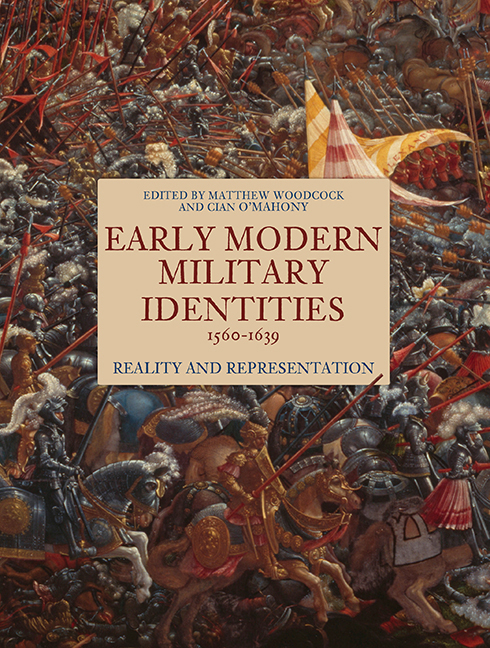Book contents
- Frontmatter
- Contents
- List of Illustrations
- List of Contributors
- Acknowledgments
- List of Abbreviations
- Introduction
- Part I Models of Military Identity
- 1 ‘Warlike prowesse and manly courage’: Martial Conduct and Masculine Identity in Late Tudor and Early Stuart England
- 2 ‘The Breviarie of Soldiers’: Julius Caesar's Commentaries and the Fashioning of Early Modern Military Identity
- 3 ‘Souldiers, or Clarkes, or both’: Ralph Knevet and the Fashioning of Military Identity through Print and Performance in Caroline Norwich
- 4 Thomas, First Lord Fairfax and ‘The Highway to Heidelberg’
- Part II Military Identities in Early odern Ireland
- Part III Staging Military Identities
- Afterword: The Way Ahead
- Bibliography
- Index
3 - ‘Souldiers, or Clarkes, or both’: Ralph Knevet and the Fashioning of Military Identity through Print and Performance in Caroline Norwich
from Part I - Models of Military Identity
Published online by Cambridge University Press: 14 September 2019
- Frontmatter
- Contents
- List of Illustrations
- List of Contributors
- Acknowledgments
- List of Abbreviations
- Introduction
- Part I Models of Military Identity
- 1 ‘Warlike prowesse and manly courage’: Martial Conduct and Masculine Identity in Late Tudor and Early Stuart England
- 2 ‘The Breviarie of Soldiers’: Julius Caesar's Commentaries and the Fashioning of Early Modern Military Identity
- 3 ‘Souldiers, or Clarkes, or both’: Ralph Knevet and the Fashioning of Military Identity through Print and Performance in Caroline Norwich
- 4 Thomas, First Lord Fairfax and ‘The Highway to Heidelberg’
- Part II Military Identities in Early odern Ireland
- Part III Staging Military Identities
- Afterword: The Way Ahead
- Bibliography
- Index
Summary
It may seem unusual that the concept of military identity would be a persistent and constant driving force for literary endeavour for a rural clergyman, with no direct experience of war, living in Norfolk in the pre-Civil War period. This chapter argues, however, that Ralph Knevet (1600–71) – in both his published work and private holograph writing – was consistently preoccupied with the formation, modelling and representation of contemporary military identity across a range of genres, including dedicatory poems and verse treatises, public entertainments drawing on contemporary pastoral drama and masque, and romance–epic. This chapter will examine Knevet's writings in order to demonstrate that a keener understanding of military identity can deepen our awareness of the significance of regional, national and international influences on poetic interpretations of statehood and cultural identity. The majority of this chapter establishes Knevet's representation of military identity in his first work, Stratiotikon (1628), before going on to consider how his approach changes and becomes more varied in his later works, Rhodon and Iris (1631) and the unpublished manuscript continuation of Edmund Spenser's great poem, A Supplement of the Faery Queene (c.1628–35). By examining Knevet's approach to military identity as a unifying theme for these works, I aim to juxtapose the insular and localised focus of his writings with the under-explored national and international scope of his political outlook and interests, and his wider ambitions for his writing. In doing so, the chapter positions Knevet as a significant regional voice in response to burgeoning concerns for the Protestant faith during the early stages of Charles I's Personal Rule and following the abortive attempts at re-establishing English and Protestant martial glory such as the ill-fated Ile de Re campaign of 1627.
Knevet employs a combination of classical, chivalric and contemporary examples to inform his work with the express intent of inspiring and instilling native military identity. Although, as is explored below, his purpose is underpinned by his Protestant world view, he maintains conciliatory attitudes towards representations of Catholicism in much of his work. As a tutor to William Paston (1610–63), first baronet of Oxnead, Norfolk, it is perhaps unsurprising – given the accusations of recusancy attached to the Paston family – that Knevet tempers the specifically confessional thrust of his rhetoric.
- Type
- Chapter
- Information
- Early Modern Military Identities, 1560–1639Reality and Representation, pp. 79 - 99Publisher: Boydell & BrewerPrint publication year: 2019

